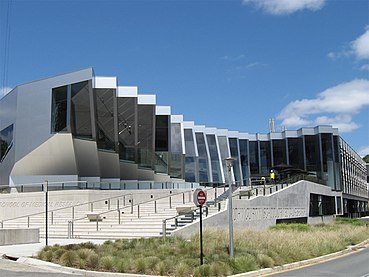John Curtin School of Medical Research
 The John Curtin School of Medical Research | |
| Founder(s) | Sir Howard Florey |
|---|---|
| Established | 1948 |
| Mission | Translational medical research and postgraduate education |
| Focus | Multidisciplinary |
| Director | Graham Mann |
| Faculty | Australian National University Medical School |
| Adjunct faculty | Canberra Hospital |
| Key people | Nobel Laureates:
|
| Owner | Australian National University |
| Location | , , , Australia |
| Coordinates | 35°16′55″S 149°06′54″E / 35.282°S 149.115°E |
| Website | jcsmr |
The John Curtin School of Medical Research (JCMSR) is an Australian multidisciplinary translational medical research institute and postgraduate education centre that forms part of the Australian National University (ANU) in Canberra. The school was founded in 1948 as a result of the vision of Nobel Laureate Sir Howard Florey and was named in honour of Australia's World War II Prime Minister John Curtin, who had died in office a few years earlier.
In addition to Florey, Sir John Eccles AC, FRS, FAA (1963)[1], Peter Doherty AC, FRS and Rolf M. Zinkernagel AC, FAA (1996),[2][3] were Nobel Laureates as a result of research conducted at the JCSMR. Other notable researchers include Gordon Ada AO, FAA, Frank Fenner AC, CMG, MBE, FRS, FAA, Sir Hugh Ennor CBE, David Roderick Curtis AC, FRACP, FAA, FRS and Chris Goodnow FRS, FAA.
The Director of the School is Professor Graham Mann.
Research focus
Doherty's research discovered the way T cells interact with the Major Histocompatibility Complex in antigen recognition. Eccles was the Foundation Professor of Physiology at JCSMR when he received the Nobel Prize in 1963 for his study of nerve cells. Since 2012, the Eccles Institute of Neuroscience has been located in a new A$60 million wing of JCSMR.
Major action star Jackie Chan made donations to the School, with the Director in 2006 announcing the Jackie Chan Science Centre was named in his honour;[4] and was opened by Chan in 2008.[5]
On 28 August 2006, the new ACRF Biomolecular Resource Facility was officially opened within the JCSMR, a new facility focusing on investigating the molecular aspects of cancer biology. The facility was partially supported by a A$1.13 million grant awarded in 2004 by the Australian Cancer Research Foundation.[6] The ARC Centre of Excellence in Vision Science also forms part of the JCSMR.
JCSMR facilities
Completed as three buildings in stages over seven years at a cost of A$130 million, the design of the building is influenced by the DNA double helix and provides education, conference, and secure research laboratory facilities.
Parts of the School were filmed during the making of the drama series, The Code,[7] broadcast on ABC TV during 2014 and 2016.
See also
References
- ^ Eccles, John (11 December 1943). The ionic mechanism of postsynaptic inhibition (PDF) (Speech). Nobel Lecture. Australian National University. Retrieved 18 September 2016.
- ^ Doherty, Peter (8 December 1996). Cell mediated immunity in virus infections (PDF) (Speech). Nobel Lecture. Australian National University. Retrieved 18 September 2016.
- ^ Zinkernagel, Rolf (8 December 1996). Cellular immune recognition and the biological role of major transplantation antigens (PDF) (Speech). Nobel Lecture. Australian National University. Retrieved 18 September 2016.
- ^ "ANU to name science centre after Jackie Chan" (Press release). Australian National University. February 2006. Archived from the original on 18 November 2006.
- ^ "Annual Report 2008" (PDF). Australian National University. 2008. p. 29. Retrieved 18 September 2016.
- ^ "The John Curtin School of Medical Research". Cancer research projects. Australian Cancer Research Foundation. 2004. Retrieved 18 September 2016.
- ^ Joyce, James (20 September 2014). "ABC series The Code changes Canberra's on-screen image". Canberra Times. Retrieved 27 October 2014.
Further reading
- Fenner, F.; Curtis, D. (2001). The John Curtin School of Medical Research; the first fifty years. Brolga Press. ISBN 1-875495-33-9.
